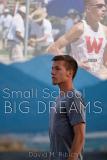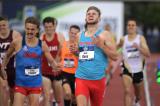Folders |
Q&A With David Ribich, Author Of Small School, Big DreamsPublished by
Ribich Offers Inside Look With 'Small School, Big Dreams' By Doug Binder, DyeStat Editor David Ribich has made some of his dreams come true. Others are still a ways off. The first-year running professional and member of the Brooks Beasts is sharing his story with a self-published journal called "Small School, Big Dreams," and it's available for pre-order Dec. 27. Ribich has come a long way since getting excited about running as a freshman at tiny Enterprise High School in Northeastern Oregon. He was 4 feet 11, weighed 86 pounds and had to sit on phone books when he learned how to drive. DYESTAT FEATURE FROM MARCH He grew into a good high school runner and blossomed at NCAA Division 2 Western Oregon University in Monmouth. He won national championships and broke Division 2 records on the way to becoming an intriguing prospect in the 1,500 meters in the buildup to the 2020 Olympic Games. Ribich's journal documents his daily life over the course of one year, from his entry into the USATF Outdoor Track and Field Championships in 2017, through his senior year at Western Oregon, and up to the date he signed with Brooks. What follows is an interview with Ribich, the author and athlete, about his book project. Where did the idea of writing a book come from? David Ribich: I started the journal the night before my first USA prelim. I just started journaling as a way to deal with my nervousness and thoughts leading up to that race. At that time, I had zero intention of publishing it or making it a full book. But when I started journaling, I found that I liked doing it, so I thought 'I'll do it through my senior year.' And then, when I went to Steens Mountain Running Camp, I was a guest speaker there and one of the kids asked whether I had thoughts of publishing the journal and at that moment I thought, 'This might actually be something that I can do.' So I said, 'Yeah, I'm going to publish it after my senior year when I sign a professional contract.' At that point, I had just promised 300 people that I was going to do it, so that was the initial motivation to get it done. What was your writing process like? DR: It was a pretty tedious process. I would write in my journal every single night. So, I have two journals that are completely full. And what I would do throughout my senior year is, on trips while we were traveling or when I didn't have as much homework certain nights, I would type what was in my written journal onto a Word document. Did you write every single day? DR: The first couple of months, July and August (2017), I was still getting into the groove of it. Pretty much from September until I signed the contract it was every single day. There's some days where I wrote a paragraph or a paragraph and a half and other days I wrote two pages, when I had more to talk about or more on my mind. If I had a day where I literally ran five miles and watched Netflix the rest of the time, I didn't really need to say much. As you wrote the journal, did you have a particular audience in mind? DR: The audience is an athlete, any distance running or track and field athlete. There are places in the journal where I say, 'Today, we did this...You should do ....' so it's almost like I'm speaking to someone. A lot of the journal focuses on my daily life but I really tried to make it applicable to the reader. There's even a spot where I say, 'I'm not sure if anyone's reading this anymore.' Technically, I don't know. On Dec. 31, I talked about my plan for 2018 and it was like, 'If you're reading this, then that means I've published the journal and my senior year is over. You tell me, how accurate was I in completing my goals?' The audience is really any high school athlete or collegiate athlete because at the end of the day we're all developing athletes and that's kind of what I wanted to emphasize. Do you still journal now that this project is over? DR: I still journal. I took July and August completely off from journaling and just kind of vegged out and didn't have to think about it. This month of December has been my hardest month to journal because I'm balancing training with putting this book out, but I still do it. Who helped you? DR: My sister Madison. She has published two children's books and works as ghost writer for various companies. She lives in France. She was the expert behind all (the editing) and choosing to go through Amazon. I just did self-publishing rights through Amazon, so I purchaed my own ISBN number. So I own the book. And if I purchase 50 copies for print costs I can just go around and sell them at a meet or a bookstore. My sister was the mastermind behind that. I wanted to self-publish, because: a) publishers cost a lot of money and b) at the end of the day I'm not really interested in the money aspect, but more just letting people who are interested have this opportunity to read it. How do you hope this book can help someone? DR: I hope it can help in a variety of ways. It can give insight into my mindset leading up to a race. I'm in an interesting spot because I've become a professional athlete but I still look up to a lot of professional athletes that I compete against. I don't want to print a book that says I know everything, or this is the way to do it. This is my own personal story. I hope that someone reading it can find that in my own progression I wasn't recruited to a Division 1 school. I was the 67th best 1,500-meter runner my senior year coming out of Oregon. If it's a high school athlete reading it, maybe they will get my personality and my insight on developing as an athlete mentally and physically. And for college-bound athletes I talk about selecting a school and how I selected my school. And then there's information in the latter half about contracts and agencies and communication that's necessary when you transition to post-collegiate. I remember I would message (Drew) Windle a lot and ask, 'Hey, I haven't been contacted by any coaches or agents yet, is that normal?' He'd say, 'Dude, it's November, it's all fine. Just relax.' Really this journal shows the process of my senior year and taking the next step in my career. So does this book explain things in a way that you haven't seen before? DR: I would have loved to see what Kyle Merber did his senior year, (or) Ben Blankenship (and others). It's insight as well as training. I know distance runners are some of the biggest nerds of track and field and read everything they can get their hands on. For track junkies, this is just another thing for those people to read. It's from a Division 2 perspective as well, which I hope is intriguing because my audience is a little bit different. I didn't go to a Division 1 program so my insights are about what it's like to be at a smaller school, and what that meant to me. What does Small School, Big Dreams mean to you? DR: My entire life I pretty much came from that background of Small School, Big Dreams. Even when I was a freshman in high school I was a small kid with a big dream. Just because you're from a small school doesn't mean you have to have a small dream. It doesn't matter the school, doesn't matter the resources. What really matters is how big your heart is and how big your mindset is to accomplish what you want to accomplish. I still got a long ways to go in terms of accomplishing the things I want to do. I've been able to do (some) things so far from a small Division 2 school and from a small high school. I went to Enterprise High School in September and I did a speaking engagement, talked about that idea of small school, big dreams and what it meant to me. I encouraged them to pursue dreams beyond high school and beyond college. High school is not a definining factor in your dreams. It's just four years that go by pretty quick. Small School, Big Dreams is an idea I've always carried around because no matter the school I was still racing top collegiate athletes. I was from Western Oregon University but I was racing guys like Josh Kerr, Justyn Knight, Sam Prakel and so, yeah, it was a different side of the story that I wanted to portray. Now that you are a pro what is your Big Dream? DR: I want to go as far in the sport as I can and inspire people along the way. I don't want to make World teams for myself. I really want to make World teams for everything that I've represented. What's nice is I don't feel like I have a great weight on my shoulders, like I need to do it for them. But I feel like it's something that drives me and encourages me to keep doing what I'm doing. And so, we have 2019 Doha, then 2020 is next year, and those are going to be the focus points of the next two years. I just want to be able to race at the highest level possible.
|








